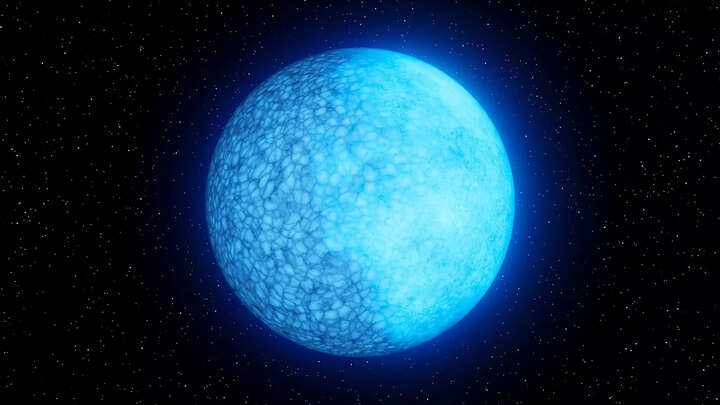Scientists spot exotic ‘two-faced’ white dwarf star, here’s what is interesting about it
FILE PHOTO: An artist’s concept shows the two-faced white dwarf star nicknamed Janus. The blue-tinted dead cinder of a star, which was once a star like our sun, is composed primarily of hydrogen on one side and helium on the other (the hydrogen side appears brighter). On the helium side, which appears bubbly, convection has destroyed the thin hydrogen layer on the surface and brought up the helium underneath. K. Miller, Caltech/IPAC/Handout via REUTERS. File Photo
Scientists have observed a white dwarf star in the Milky Way galaxy about 1,300 light years from Earth. This is a one-of-a-kind discovery because the dense hot remnant object has the peculiar distinction of being composed of hydrogen on one side and helium on the other. It has been nicknamed Janus.
“Janus is the Roman god with two faces, so we thought it was very appropriate. Moreover, Janus is the god of transition, and the white dwarf might be currently transitioning from having an atmosphere made of hydrogen to one made of helium,” said Ilaria Caiazzo, a Caltech postdoctoral fellow in astrophysics.
Janus is said to have a mass 20% larger than our sun compressed into an object with a diameter half that of Earth. It rotates on its axis every 15 minutes, which is very fast if you compare it with other stars that usually rotate every few hours to a few days. Earth takes 24 hours to complete a rotation.
“White dwarfs form at the very end of a star’s life. About 97% of all stars are destined to become white dwarfs when they die,” added Caiazzo, who is lead author of the study, which was published in the journal Nature.
“Our sun, for example, is currently burning hydrogen into helium in its core. When the hydrogen in the core is depleted, the sun will start burning helium into carbon and oxygen. When the helium also is gone from the centre, the sun will eject its outer layers into space in an event called a planetary nebula and the core will slowly contract and become a white dwarf,” Caiazzo added. This is not expected to happen before 5 billion years.
After a white dwarf forms, its heavier elements are thought to sink to the star’s core while its lighter elements – hydrogen being the lightest, followed by helium – float to the top.
Development of one side being hydrogen while the other side is helium is suspected to be caused by the dwarf’s magnetic field. “Many white dwarfs are expected to go through this transition, and we might have caught one in the act because of its magnetic field configuration,” Caiazzo said.
FacebookTwitterLinkedin
end of article

FILE PHOTO: An artist’s concept shows the two-faced white dwarf star nicknamed Janus. The blue-tinted dead cinder of a star, which was once a star like our sun, is composed primarily of hydrogen on one side and helium on the other (the hydrogen side appears brighter). On the helium side, which appears bubbly, convection has destroyed the thin hydrogen layer on the surface and brought up the helium underneath. K. Miller, Caltech/IPAC/Handout via REUTERS. File Photo
Scientists have observed a white dwarf star in the Milky Way galaxy about 1,300 light years from Earth. This is a one-of-a-kind discovery because the dense hot remnant object has the peculiar distinction of being composed of hydrogen on one side and helium on the other. It has been nicknamed Janus.
“Janus is the Roman god with two faces, so we thought it was very appropriate. Moreover, Janus is the god of transition, and the white dwarf might be currently transitioning from having an atmosphere made of hydrogen to one made of helium,” said Ilaria Caiazzo, a Caltech postdoctoral fellow in astrophysics.
Janus is said to have a mass 20% larger than our sun compressed into an object with a diameter half that of Earth. It rotates on its axis every 15 minutes, which is very fast if you compare it with other stars that usually rotate every few hours to a few days. Earth takes 24 hours to complete a rotation.
“White dwarfs form at the very end of a star’s life. About 97% of all stars are destined to become white dwarfs when they die,” added Caiazzo, who is lead author of the study, which was published in the journal Nature.
“Our sun, for example, is currently burning hydrogen into helium in its core. When the hydrogen in the core is depleted, the sun will start burning helium into carbon and oxygen. When the helium also is gone from the centre, the sun will eject its outer layers into space in an event called a planetary nebula and the core will slowly contract and become a white dwarf,” Caiazzo added. This is not expected to happen before 5 billion years.
After a white dwarf forms, its heavier elements are thought to sink to the star’s core while its lighter elements – hydrogen being the lightest, followed by helium – float to the top.
Development of one side being hydrogen while the other side is helium is suspected to be caused by the dwarf’s magnetic field. “Many white dwarfs are expected to go through this transition, and we might have caught one in the act because of its magnetic field configuration,” Caiazzo said.
FacebookTwitterLinkedin
end of article
